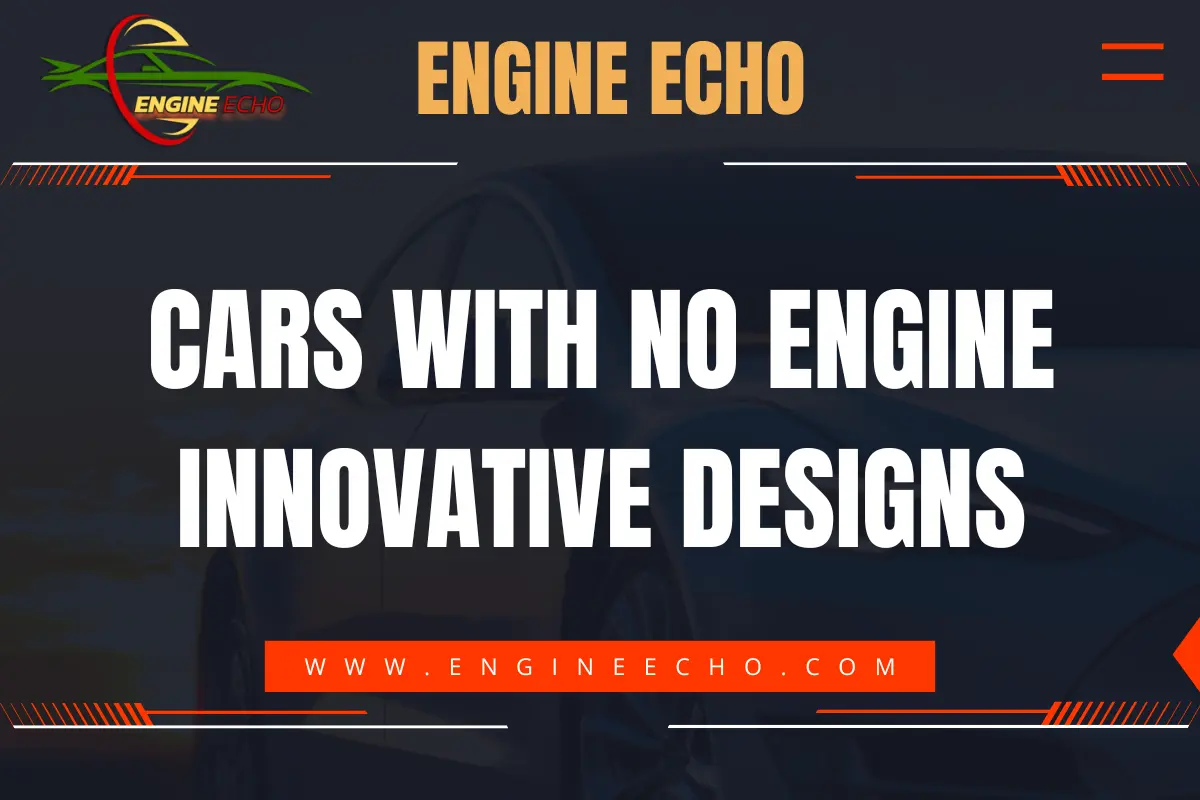Cars with No Engine: Innovative Designs

Key Takeaways
- Revolutionary Concept: Engine-less cars are redefining vehicle design by eliminating the traditional internal combustion engine and embracing alternative propulsion technologies.
- Technological Advancements: From electric and solar power to hydrogen fuel cells and magnetic levitation, these vehicles showcase cutting-edge innovations in energy use and material science.
- Environmental Benefits: Engine-less cars significantly reduce greenhouse gas emissions and dependency on fossil fuels, contributing to a cleaner environment.
- Economic and Performance Advantages: These vehicles offer lower maintenance costs, smoother driving experiences, and potentially better acceleration compared to traditional cars.
- Challenges Ahead: Infrastructure development, cost barriers, and technological hurdles are key challenges that need to be addressed for broader adoption.
- Future Trends: As advancements continue, we can expect improvements in energy efficiency, expanded use of renewable energy, and greater integration of autonomous driving technologies.
Introduction to Engine-Less Cars
The world of automotive design is undergoing a radical transformation, and at the heart of this shift are engine-less cars. These vehicles, which operate without the traditional internal combustion engine (ICE), represent a bold step toward a future that prioritizes sustainability, efficiency, and technological innovation. From my perspective, this is more than just a trend—it’s the dawn of a new era in transportation. The very idea of a car that doesn’t need an engine is both exciting and revolutionary, and it’s one that I believe will redefine how we think about mobility in the years to come. In this article, I’ll explore the various types of engine-less cars, the technology driving them, and why they’re poised to change the world.
Understanding Engine-Less Vehicles
Engine-less vehicles are paving the way for a future where cars are smarter, cleaner, and far more efficient than ever before. Unlike traditional vehicles that rely on an ICE to generate power, these cars utilize alternative methods such as electricity, solar energy, hydrogen, or even magnetic levitation. I find this shift fascinating because it marks a fundamental change in automotive engineering—a move away from complex mechanical systems toward more streamlined, eco-friendly technologies.
Differences Between Traditional Vehicles and Engine-Less Designs
- Propulsion: Traditional vehicles burn fuel to generate mechanical power, whereas engine-less cars rely on electric motors, solar energy, or other innovative technologies.
- Complexity: With fewer moving parts, engine-less cars are generally simpler and require less maintenance.
- Environmental Impact: These vehicles produce zero tailpipe emissions, which aligns perfectly with my vision of a sustainable future.
Types of Engine-Less Cars
Electric Vehicles (EVs)
Electric vehicles (EVs) are at the forefront of the engine-less car movement, and having driven one myself, I can attest to their transformative potential. The experience of driving an EV is unlike anything you’ll get from a traditional car—there’s a smoothness, a quiet efficiency, and an immediate responsiveness that makes you feel like you’re driving the future.
- Battery-Powered Cars: EVs like the Tesla Model S and Nissan Leaf rely on advanced lithium-ion batteries to power electric motors, offering impressive range and performance.
- Examples:
- Tesla Model S: This car is a game-changer, not just for its electric powertrain but for its high-tech features and incredible acceleration.
- Nissan Leaf: An accessible, reliable EV that has made electric driving a reality for thousands of people around the world.
Solar-Powered Cars
Solar-powered cars take the concept of engine-less vehicles to the next level, harnessing the sun’s energy to keep moving. The idea of a car that powers itself as it drives is incredibly compelling to me—imagine the freedom of never having to worry about finding a charging station or filling up at the pump.
- How Solar Panels Replace the Engine: Solar panels on these cars convert sunlight directly into electricity, which is stored in batteries and used to power the vehicle.
- Examples:
- Lightyear One: This vehicle is a personal favorite of mine. Its ability to travel up to 450 miles on solar energy alone is nothing short of revolutionary.
- Sono Motors Sion: A practical solar-electric hybrid that shows real promise for everyday use.
Hydrogen Fuel Cell Vehicles
Hydrogen fuel cell vehicles offer another intriguing alternative to the traditional engine. I’m fascinated by the idea of a car that uses hydrogen and emits only water vapor—it’s clean, efficient, and a testament to what’s possible with advanced technology.
- The Role of Hydrogen: Hydrogen is stored in tanks and used in fuel cells to generate electricity, with the only byproduct being water.
- Examples:
- Toyota Mirai: This car is a beacon of what hydrogen technology can achieve, offering a smooth, quiet ride with zero emissions.
- Hyundai Nexo: Another strong contender in the hydrogen space, combining advanced tech with practical functionality.
Magnetic Levitation (Maglev) Cars
Magnetic levitation cars are something out of a science fiction dream, using magnetic fields to lift and propel the vehicle. The thought of cars that glide above the ground without the need for an engine is as exciting as it is futuristic.
- Use of Magnetic Fields for Propulsion: Maglev technology, which eliminates friction and allows for ultra-smooth, high-speed travel, is still in its infancy for cars but shows enormous potential.
- Conceptual Designs and Prototypes: While these cars are mostly conceptual at this stage, the possibilities they represent are truly inspiring.
Technological Innovations in Engine-Less Cars
Battery Technology
Battery technology is the linchpin of the engine-less car revolution. The advancements we’re seeing in this area are nothing short of extraordinary, with each new development bringing us closer to a world where these vehicles are not just viable but preferable.
- Advances in Lithium-Ion and Solid-State Batteries: These technologies are increasing the range, reducing charging times, and improving the overall safety of engine-less cars.
- Impact on Vehicle Performance and Range: As batteries become more efficient, the practicality of engine-less vehicles continues to improve, making them more appealing to a wider audience.
Renewable Energy Integration
One of the aspects of engine-less cars that excites me the most is their potential to integrate renewable energy sources. The idea that a car could be powered entirely by the sun or wind is not just a dream—it’s a rapidly approaching reality.
- Solar Energy Capture and Conversion: Cars like the Lightyear One are leading the charge in this area, offering the possibility of true energy independence.
- Use of Wind and Other Renewable Sources: While still experimental, the integration of wind and other renewable energy sources into vehicle design is a promising area of research.
Material Science
The materials used in engine-less cars are just as innovative as the propulsion systems. I’m particularly impressed by the use of lightweight, durable materials like carbon fiber and graphene, which are helping to push the boundaries of what these vehicles can do.
- Lightweight Materials for Better Efficiency: These materials reduce weight without sacrificing strength, which is crucial for maximizing efficiency and range.
- Carbon Fiber, Graphene, and Other Innovative Materials: By using these advanced materials, manufacturers are able to create vehicles that are both strong and incredibly light, improving performance and safety.
Autonomous Driving Integration
The combination of engine-less technology and autonomous driving is something I find particularly exciting. Together, these innovations have the potential to create vehicles that are not only cleaner and more efficient but also far safer and more convenient.
- Synergy Between Engine-Less Cars and Autonomous Technology: Autonomous systems can optimize driving patterns for better energy efficiency, making the most out of the engine-less powertrains.
- Examples of Self-Driving, Engine-Less Cars: Vehicles like the Tesla Model 3 are already showcasing what this future could look like, combining electric power with advanced self-driving capabilities.
Benefits of Engine-Less Cars
Environmental Impact
The environmental benefits of engine-less cars are perhaps their most compelling feature. For me, the reduction in greenhouse gas emissions and the decreased reliance on fossil fuels are major reasons to support this technology.
- Reduction in Greenhouse Gas Emissions: These vehicles produce no tailpipe emissions, which is a huge step forward in the fight against climate change.
- Lower Reliance on Fossil Fuels: By using electricity, hydrogen, or renewable energy, engine-less cars reduce our dependence on oil and other non-renewable resources, aligning with my personal values and vision for a sustainable future.
Economic Benefits
Engine-less cars offer significant economic advantages as well. From lower maintenance costs to potential government incentives, these vehicles make financial sense for a lot of people.
- Lower Maintenance Costs: With fewer moving parts, engine-less cars are less likely to need costly repairs, which can save drivers a lot of money over time.
- Government Incentives and Subsidies: Many governments are offering financial incentives to encourage the purchase of environmentally friendly vehicles, making them more affordable and accessible.
Performance and Comfort
Having driven an electric vehicle, I can personally attest to the superior performance and comfort these cars offer. The quietness, the smooth acceleration, and the lack of engine noise make for a driving experience that’s hard to match.
- Quiet and Smooth Driving Experience: The absence of an engine makes these cars incredibly quiet, creating a more peaceful driving environment.
- Better Acceleration and Torque: Electric motors provide instant torque, resulting in faster acceleration and a more responsive drive, which is something I really appreciate in a vehicle.
Challenges and Limitations
Infrastructure Needs
Despite all the benefits, engine-less cars do face some significant challenges. One of the biggest is the need for better infrastructure, particularly when it comes to charging stations and hydrogen refueling points.
- Charging Stations and Hydrogen Refueling Stations: Expanding this infrastructure is critical for making engine-less cars a viable option for more people, especially in areas where such facilities are currently lacking.
- Integration with the Existing Energy Grid: As more vehicles draw power from the grid, ensuring stability and capacity will be a major challenge that needs to be addressed.
Cost Considerations
Another challenge is the cost. While I’m optimistic that prices will come down as technology advances, the high initial cost of these vehicles is still a barrier for many consumers.
- High Initial Costs of Technology: Advanced batteries, fuel cells, and materials drive up the initial cost of these vehicles, making them less accessible to the average consumer.
- Long-Term Affordability for Consumers: While the running costs are lower, the upfront price can still be a significant hurdle for many potential buyers, which is something that needs to be addressed through continued innovation and economies of scale.
Technological Hurdles
There are also several technological challenges that need to be overcome before engine-less cars can truly replace their traditional counterparts. From battery life to hydrogen storage, these are areas where ongoing research is essential.
- Battery Life and Charging Time: Improving battery longevity and reducing charging times are key to making electric vehicles more practical for everyday use, which is crucial for wider adoption.
- Hydrogen Storage and Distribution Challenges: Storing and transporting hydrogen safely and efficiently remains a significant challenge, and it’s one that needs to be solved if hydrogen fuel cell vehicles are to become a mainstream option.
Case Studies: Engine-Less Cars in Action
Tesla Model 3
The Tesla Model 3 is a perfect example of how an electric car can achieve mainstream success. I’ve followed Tesla’s progress closely, and the Model 3’s blend of performance, range, and affordability has made it one of the best-selling EVs globally.
Lightyear One
The Lightyear One is a solar-powered car that I find particularly inspiring. Its ability to harness solar energy for long-distance travel without frequent recharging is a game-changer in the industry, and it’s a vehicle that I believe could lead the way for future innovations.
Toyota Mirai
The Toyota Mirai is another vehicle that stands out to me. Its use of hydrogen fuel cell technology demonstrates the potential for a clean, sustainable alternative to gasoline-powered cars, and it’s a car that could pave the way for a hydrogen-based future.
Concept Cars
Concept cars like the Mercedes-Benz Vision AVTR offer a fascinating glimpse into what the future of automotive design could look like. These vehicles not only explore new propulsion methods but also integrate advanced materials and autonomous technology in ways that could completely redefine the driving experience.
Future Trends in Engine-Less Vehicle Design
Advancements in Autonomous Tech
The future of engine-less cars is closely tied to advancements in autonomous technology. I believe that as self-driving systems become more sophisticated, they will play a crucial role in optimizing energy use and improving safety, making engine-less cars even more attractive.
- Predictive Driving and AI Integration: Future cars may use AI to predict and adapt to driving conditions, improving efficiency and safety in ways that we’re only beginning to imagine.
Energy Efficiency Improvements
Improvements in energy efficiency are essential for the continued success of engine-less cars. I’m particularly excited about the potential of new battery chemistries and energy sources to enhance vehicle performance and sustainability.
- New Battery Chemistries: Innovations like solid-state batteries could dramatically improve energy density and charging times, making engine-less cars more practical and appealing.
Expansion of Renewable Energy Use
The expansion of renewable energy use in vehicles is something I’m passionate about. I look forward to a future where cars can generate all the power they need from renewable sources, leading to a more sustainable and self-sufficient world.
- Fully Self-Sustaining Vehicles: As solar and other renewable technologies advance, we could see vehicles that are entirely self-sufficient, reducing our reliance on external power sources and making a significant impact on the environment.
Comparing Engine-Less Cars with Traditional Vehicles
Environmental Impact
When comparing engine-less cars to traditional vehicles, the environmental benefits are clear. For me, the reduction in emissions and resource consumption is a major reason to support this technology, and it’s one of the main reasons I believe in the future of engine-less cars.
- Emissions Comparison: Engine-less cars produce zero tailpipe emissions, while ICE vehicles are a major source of pollution. This is a significant step forward in reducing our environmental footprint.
- Resource Consumption Differences: Engine-less cars often use fewer resources over their lifetime, especially as battery recycling technologies improve, making them a more sustainable choice overall.
Performance Metrics
While traditional cars have long dominated in terms of performance, engine-less cars are quickly closing the gap. I’ve found that the acceleration and range of electric vehicles, in particular, can rival and even surpass that of their gas-powered counterparts.
- Acceleration, Range, and Durability: Electric motors provide rapid acceleration, and improvements in battery technology are extending the range and lifespan of these vehicles, making them a viable alternative to traditional cars.
Cost Analysis
The total cost of ownership is becoming more favorable for engine-less cars as prices drop and running costs remain low. I recommend considering not just the purchase price but the long-term savings these vehicles can offer, as they often prove to be more economical in the long run.
- Total Cost of Ownership Over Time: Despite higher initial costs, engine-less cars can be cheaper to own in the long run due to lower fuel and maintenance costs, making them a smart financial choice for many consumers.
Public Perception and Adoption
Consumer Attitudes
Public interest in engine-less cars is growing, and I’ve noticed this shift in conversations with friends and colleagues. People are becoming more aware of the environmental and economic benefits, though there’s still some hesitation, largely due to a lack of understanding of the technology.
- Survey Data on Public Interest: Surveys show increasing willingness to adopt electric and other alternative vehicles, reflecting a growing awareness of their benefits and a shift in consumer attitudes.
Barriers to Adoption
Despite growing interest, there are still barriers to adoption. I’ve encountered skepticism about the reliability and safety of these vehicles, which highlights the need for more education and awareness.
- Misconceptions and Knowledge Gaps: Educating the public on the benefits and realities of engine-less cars is crucial for wider adoption, and it’s something that I believe will be essential for the success of this technology.
Market Growth
The market for engine-less cars is expanding rapidly, with sales increasing year over year. Countries like Norway and China are leading the way, and I believe this trend will only continue as technology advances and infrastructure improves.
- Trends in Sales and Adoption Rates Globally: Countries like Norway and China are at the forefront of electric vehicle adoption, setting the stage for a global shift towards engine-less cars and a more sustainable future.
Policy and Regulation
Government Initiatives
Supportive policies are crucial for the growth of the engine-less vehicle market. I’ve noticed that subsidies, tax incentives, and regulatory frameworks are making these cars more accessible to a broader audience, which is essential for driving adoption.
- Subsidies, Tax Incentives, and Regulatory Frameworks: Many governments are offering financial incentives to encourage the purchase of environmentally friendly vehicles, making them more affordable and accessible to the general public.
Safety Standards
As engine-less cars become more common, safety regulations are evolving to address new risks and technologies. I believe that ensuring the safety of these vehicles is essential for gaining public trust and driving adoption.
- Regulations Specific to Engine-Less Vehicle Technology: Standards are being developed for battery safety, autonomous driving, and more, ensuring that these vehicles meet the highest safety standards and can be trusted by consumers.
Global Policies
Different countries are adopting various strategies to promote engine-less vehicles, with Europe and Asia leading the charge. I’m particularly interested in how these global policies will shape the future of the automotive industry, and I believe that they will play a crucial role in driving the adoption of engine-less cars worldwide.
- Comparison of Policies Across Different Countries: While the EU focuses on strict emissions targets, China is rapidly expanding its EV market through aggressive subsidies, and these policies are having a significant impact on the global automotive landscape.
Conclusion
Engine-less cars are not just a futuristic concept—they are already reshaping the automotive landscape. I’m excited about the potential these vehicles hold, not just for reducing our environmental footprint, but for offering a superior driving experience. As technology continues to advance, and as infrastructure and policies evolve, I believe engine-less cars will become the standard, driving us into a cleaner, more efficient future.
Frequently Asked Questions (FAQs)
- What defines an engine-less car? An engine-less car is a vehicle that does not rely on an internal combustion engine (ICE) for propulsion, instead using electric motors, solar energy, hydrogen fuel cells, or other alternative technologies.
- How do engine-less cars compare to electric vehicles? While all electric vehicles (EVs) are engine-less by definition, not all engine-less cars are purely electric. Some may use hydrogen fuel cells or other technologies.
- What are the primary energy sources for engine-less cars? The main energy sources include electricity (from batteries or renewable sources like solar), hydrogen (in fuel cells), and magnetic fields (for maglev vehicles).
- What are the long-term benefits of transitioning to engine-less cars? Transitioning to engine-less cars can reduce greenhouse gas emissions, lower dependency on fossil fuels, decrease maintenance costs, and lead to quieter, more comfortable driving experiences.
Thanks for checking out this article on EngineEcho.com! Hope you found this article: "Cars with No Engine: Innovative Designs" helpful! If you liked it and want to dive into more car engine topics, head over to our homepage. There's always something new to discover in the world of engines. Enjoy your reading journey!
Check out our previous article: Cars with LS3 Engine: Performance Review






